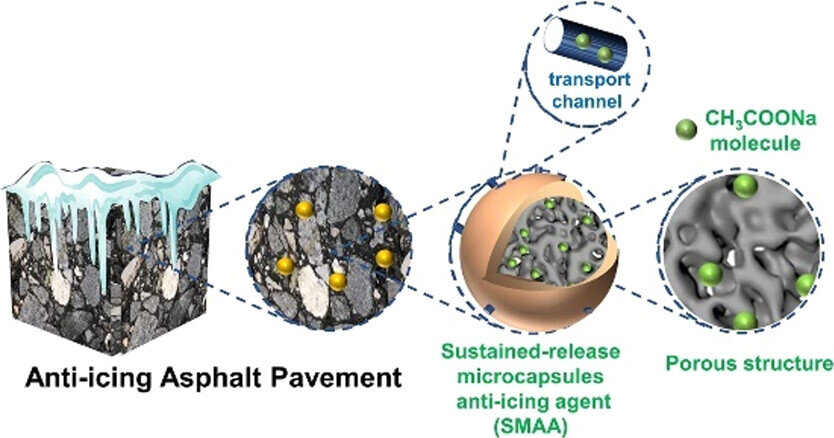Keeping drivers safe with a road that can melt snow, ice on its own
Slipping and sliding on snowy or icy roads is dangerous. Salt and sand help melt ice or provide traction, but excessive use is bad for the environment. And sometimes, a surprise storm can blow through before these materials can be applied. Now, researchers reporting in ACS Omega have filled microcapsules with a chloride-free salt mixture that’s added into asphalt before roads are paved, providing long-term snow melting capabilities in a real-world test.
Driving on snowy roads at or near-freezing temperatures can create unsafe conditions, forming nearly invisible, slick black ice, if roads aren’t cleaned quickly enough. But the most common ways to keep roads clear have significant downsides:
- Regular plowing requires costly equipment, is labor intensive and can damage pavement.
- Heavy salt or sand applications can harm the environment.
- Heated pavement technologies are prohibitively expensive to use on long roadways.
Recently, researchers have incorporated salt-storage systems into “anti-icing asphalt” to remove snow and prevent black ice from forming. However, these asphalt pavements use corrosive chloride-based salts and only release snow-melting substances for a few years. So, Yarong Peng, Quansheng Zhao, Xiaomeng Chu and colleagues wanted to develop a longer-term, chloride-free additive to effectively melt and remove snow cover on winter roads.
The researchers prepared a sodium acetate salt and combined it with a surfactant, silicon dioxide, sodium bicarbonate and blast furnace slag—a waste product from power plant operations—to produce a fine powder. They then coated the particles in the powder with a polymer solution, forming tiny microcapsules. Next, the team replaced some of the mineral filler in an asphalt mixture with the microcapsules.
In initial experiments, a pavement block made with the new additive lowered the freezing point of water to -6 F. And the researchers estimated that a 5-cm-thick layer of the anti-icing asphalt would be effective at melting snow for seven to eight years.
A real-world pilot test of the anti-icing asphalt on the off-ramp of a highway showed that it melted snow that fell on the road, whereas traditional pavement required additional removal operations. Because the additive used waste products and could release salt for most of a road’s lifetime, the researchers say that is a practical and economic solution for wintertime snow and ice removal.
More information:
Yingfei Zhao et al, Preparation of a Green Sustained-Release Microcapsule-Type Anti-Icing Agent for Asphalt Pavement and Its Application Demonstration Project, ACS Omega (2023). DOI: 10.1021/acsomega.2c07212
Citation:
Keeping drivers safe with a road that can melt snow, ice on its own (2023, February 16)
retrieved 16 February 2023
from https://techxplore.com/news/2023-02-drivers-safe-road-ice.html
This document is subject to copyright. Apart from any fair dealing for the purpose of private study or research, no
part may be reproduced without the written permission. The content is provided for information purposes only.
For all the latest Technology News Click Here
For the latest news and updates, follow us on Google News.

